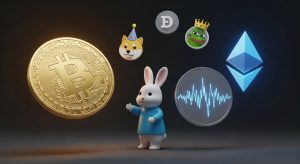This blog will guide you through Web3 fundamentals, current trends like AI integration and tokenization, and practical steps to understand and use blockchain technology today.
For a head start on key Web3 terms and how to manage assets, check out our list of top Web3 wallets for secure interaction with decentralized apps. Web3 and blockchain technology mark a major shift from the traditional internet model most people know.
Unlike the old web where central companies control the data, Web3 puts power back in users’ hands through decentralized networks.
Blockchain technology forms the foundation for this system, offering transparency, improved security, and direct ownership of digital assets.
This change means more control over personal information and transactions, plus new ways to engage with online services without middlemen.
As we look at the year, these technologies are growing more scalable and efficient, influencing everything from finance to gaming.
Understanding these basics helps make sense of the trends shaping how we’ll interact with the internet moving forward.
For a practical start on managing your digital assets in Web3, exploring the best Web3 wallets can be a great first step.
Meanwhile, if you’re interested in how to pick digital currencies wisely, our guide on how to choose the best cryptocurrency offers clear advice tailored for beginners and traders alike.
Understanding Blockchain and Web3 Fundamentals

When you hear people talk about blockchain and Web3, it can sound complex, but the core ideas are pretty simple and powerful.
Blockchain is like a shared digital notebook that everyone can see and trust, but no single person owns it.
Web3 uses this technology to build a new kind of internet where users, not big companies, control their own data and digital assets.
This section will give you a clear picture of what makes blockchain and Web3 tick. You’ll understand what these technologies do, why they matter, and how they come together to reshape how we interact online.
What Is Blockchain?
At its heart, blockchain is a type of database. Unlike traditional databases controlled by one entity, a blockchain is distributed across many computers (called nodes).
Each part of the chain holds a record of transactions or data in blocks linked together, making it very hard to change any single record without everyone agreeing.
This setup brings three important benefits:
-
Transparency: Everyone gets to see the same information.
-
Security: Changing old records requires massive computing power, protecting against hacks or fraud.
-
Decentralization: No middleman controls or owns the data.
You can think of it like a digital ledger passed around to a group. Each person checks that the notes make sense and agrees before writing something new.
This prevents cheating and builds trust, even between strangers.
What Is Web3?
Web3 takes the foundation of blockchain to create a new internet experience.
Instead of relying on servers owned by big corporations, Web3 apps run on decentralized networks where users have full control over their identity, data, and assets.
Some key ideas behind Web3 include:
-
User Ownership: You hold the keys to your data and digital identity, usually via cryptographic wallets.
-
Decentralized Apps (dApps): These programs run across blockchain networks, not a single server.
-
Smart Contracts: These are self-executing agreements coded on the blockchain, removing the need for intermediaries.
-
Tokenization: Digital assets like NFTs or cryptocurrencies represent ownership or access rights on Web3.
Imagine owning your house keys instead of renting from a landlord who controls access. That’s what Web3 aims to offer users: more control and freedom in how they use the internet.
How Blockchain and Web3 Work Together
Blockchain acts as the reliable database behind Web3’s decentralized vision. It stores all transaction records and smart contract codes in a tamper-proof way.
Web3 apps then use this to:
-
Enable trustless interactions where users don’t rely on middlemen.
-
Manage digital ownership of assets like cryptocurrencies, NFTs, or tokens.
-
Provide transparent processes that anyone can audit or verify.
These benefits open up possibilities in finance, gaming, social media, and more. As these technologies improve in speed and efficiency, expect to see them play a bigger role in everyday online activities.
For example, the Sui blockchain overview explains a layer-1 platform built for fast, low-cost transactions that fit well with Web3 ambitions. Understanding these basics helps you follow the innovations transforming how the internet works today and tomorrow.
Key Trends Shaping Web3 and Blockchain

As Web3 and blockchain continue expanding, some clear trends are defining how these technologies will grow.
These shifts focus on smarter automation, new ways to own assets, and fresh economic models that bring more people into the ecosystem.
Understanding what’s driving these changes helps you stay ahead and see where practical opportunities lie. See a comprehensive guide on how blockchain acts as a database, Blockchain Database: A Comprehensive Guide.
Artificial Intelligence Enhancing Blockchain
Artificial intelligence (AI) is becoming a key partner to blockchain in Web3. By integrating AI, smart contracts, which are self-executing agreements on blockchain, can get more flexible and intelligent.
Instead of following fixed rules, they can adapt to changing conditions, making decision-making more dynamic and responsive.
Within decentralized organizations, AI optimizes how collective decisions are made, analyzing huge data sets faster than humans.
This leads to smarter governance and better resource management on blockchains.
AI agents also speed up development and marketing for Web3 projects by automating tasks like code testing, community engagement, and trend analysis.
They help teams respond quickly to market shifts and user feedback, making projects more competitive.
Tokenization of Real-World Assets
One of the biggest trends gaining traction is tokenizing physical assets like real estate, art, and commodities.
This means turning ownership rights of these tangible items into digital tokens traded on blockchain networks.
Tokenization brings several clear benefits:
-
Fractional Ownership: You don’t need to buy a whole property or artwork; instead, you can own a share represented by tokens.
-
Increased Liquidity: Selling fractions of expensive assets becomes easier and faster since tokens trade on markets 24/7.
-
Lower Investment Barriers: It opens up previously pricey markets to everyday investors, not just wealthy buyers.
This combination attracts both retail buyers and institutions who want to diversify portfolios or tap new investment classes without geographical limits.
The Rise of Decentralized Physical Infrastructure Networks (DePINs)
Decentralized Physical Infrastructure Networks, or DePINs, represent a new way to build and maintain infrastructure using blockchain incentives.
Individuals contribute resources such as bandwidth, storage, or computing power to these networks and earn tokens in return.
These networks include projects powering decentralized internet, file storage, or computing grids.
DePIN models create fresh economic opportunities by compensating everyday users for their resources instead of relying solely on big providers.
This trend is reshaping how infrastructure is funded and operated, offering transparency and fairness while scaling digital networks through collective participation.
Each of these trends points to Web3 and blockchain becoming more interactive, accessible, and community-driven.
You can expect these forces to unlock new ways to earn, invest, and participate in decentralized ecosystems.
Technical Advances Boosting Blockchain Utility

Blockchain technology is evolving rapidly as developers focus on making it more practical, secure, and environmentally friendly.
These advances drive stronger adoption across industries by solving some of the key challenges blockchain once faced.
Two areas seeing important progress are identity management and sustainability.
These improvements expand blockchain’s usefulness well beyond cryptocurrencies, making it a more trusted and responsible technology for everyday use.
Decentralized Identity and Privacy Enhancements
Managing identity online has always been tricky. Traditional systems require users to hand over personal data to centralized authorities, exposing them to data breaches and surveillance.
Blockchain introduces a better way with decentralized identity (DID) and self-sovereign identity (SSI).
These frameworks shift control back to the user. Instead of relying on a single organization to verify and store your data, you hold your digital credentials securely in a blockchain-based wallet.
This approach cuts out middlemen and reduces the risk of misuse or hacking. You decide when and with whom to share your information, keeping sensitive data private by design.
Self-sovereign identity means you are the authority on your identity. It supports smoother, safer online interactions, whether it’s logging into websites or proving credentials like licenses or diplomas.
The transparent nature of blockchain also allows users and service providers to verify identities without exposing unnecessary details.
By letting users own and manage their digital identities, blockchain can rebuild trust in the way personal data is handled online. This not only improves security but also gives individuals greater freedom and privacy.
Sustainable Blockchain Initiatives
Blockchain’s early reputation was hurt by its huge energy consumption, especially networks using Proof-of-Work (PoW), which require massive computing power.
In response, the industry is shifting toward eco-friendly alternatives.
Proof-of-Stake (PoS) has emerged as a popular consensus model that slashes energy use by orders of magnitude.
Instead of miners racing to solve complex puzzles, PoS chooses validators based on the amount they stake. This method validates transactions in a fraction of the time and energy PoW demands.
The environmental benefits are clear: much lower carbon footprints and reduced strain on hardware resources.
These green blockchain solutions attract users and businesses who care about sustainability. Large networks like Ethereum have already transitioned to PoS, setting an example for the rest of the industry.
As more projects prioritize eco-friendly practices, blockchain becomes a more viable tool for industries with strict environmental standards.
This growing preference for sustainable blockchains reflects a market eager to harness crypto innovation without sacrificing the planet.
By lowering environmental impact and boosting energy efficiency, these initiatives make blockchain technology both practical and responsible for the long run.
This section highlights how blockchain is advancing in ways that improve security, privacy, and sustainability, key factors in its wider acceptance and use.
These technical improvements will shape how we manage identity and environmental impact as Web3 expands.
Web3 Ecosystem Growth and Challenges
The Web3 ecosystem is expanding rapidly, drawing in more developers, users, and businesses eager to explore blockchain’s potential.
This growth creates exciting opportunities but also exposes a range of challenges that must be addressed to keep the momentum going.
Understanding both the progress and the hurdles gives you a clearer picture of where this space stands today and what lies ahead.
Growth Drivers in the Web3 Ecosystem
Several factors have sparked Web3’s recent expansion, helping it gain traction beyond just technical circles:
-
Wider adoption of decentralized finance (DeFi): More platforms enable users to borrow, lend, and trade without traditional banks. This boosts financial inclusion and user control.
-
Increasing numbers of decentralized apps (dApps): These offer fresh ways for people to earn, connect, and share ownership online, spanning from gaming to social media.
-
Improved infrastructure: Faster, more scalable blockchains, like those explained in our Sui blockchain overview, reduce transaction costs and delays, making Web3 more user-friendly.
-
Growing institutional interest: Venture funding and corporate partnerships bring legitimacy and resources, helping Web3 projects scale.
-
Cross-chain interoperability: Protocols linking different blockchains enhance user experiences and asset mobility across ecosystems.
Together, these factors build a foundation where Web3 becomes a real alternative to traditional online platforms.
Key Challenges Slowing Web3’s Progress
Despite strong growth, Web3 still faces significant obstacles that affect adoption and development:
-
User experience and complexity: Many Web3 tools remain confusing or intimidating for newcomers. Wallet setups, gas fees, and transaction delays can frustrate users.
-
Regulatory uncertainty: Governments worldwide are still figuring out how to regulate cryptocurrencies and decentralized platforms. This uncertainty scares off some investors and developers.
-
Scalability limits: Even with improvements, some blockchains struggle under heavy traffic, slowing down apps or increasing fees during busy periods.
-
Security risks and scams: Poorly audited smart contracts and phishing attacks lead to losses, damaging trust in the ecosystem.
-
Fragmentation: The variety of blockchains and protocols can cause confusion and create silos, making it tough to build truly seamless cross-platform experiences.
Addressing these challenges will require continued innovation, clearer regulations, and a focus on improving access for mainstream users.
Building a More Sustainable and Inclusive Web3
To unlock Web3’s full potential, the ecosystem needs to balance expansion with practical solutions for these pain points. This means prioritizing:
-
Simplified interfaces and education to improve accessibility.
-
Collaborative efforts between regulators, developers, and users to find fair, workable rules.
-
Investment in scalable, energy-efficient blockchain technologies.
-
Stronger security standards and community-driven trust mechanisms.
-
Enhanced interoperability across networks to reduce fragmentation.
These steps will help Web3 grow in a way that benefits a wide, diverse audience—not just early adopters or technical experts.
By understanding both the growth drivers and the challenges, you’ll be better equipped to navigate Web3’s evolving landscape and spot genuine opportunities.
Conclusion
Web3 and blockchain are moving beyond hype into practical, real-world use in 2025. Advances in AI integration, tokenization of assets, and sustainable blockchain solutions are driving this adoption.
These developments create more secure, efficient, and inclusive ways to interact online and invest.
Staying informed on these changes can help you make smarter decisions in trading or managing crypto assets.
The technology’s steady growth shows it will increasingly shape finance, business, and digital ownership.
For more on the evolving cryptocurrency environment, check out the current cryptocurrency trends today.

Adeyemi Adetilewa is interested in blockchain, cryptocurrency, and web3. When he is not looking for the next alpha, he is busy working as a husband and father.

